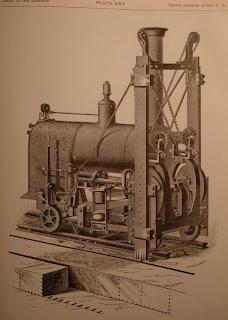So you’re heading out to Washington D.C. to attend the inauguration and wondering what to do in the down time between the Bruce Springsteen concert, primping for the Inaugural Ball, and chatting up your local congressional representative on the importance of a good geology education. Well, like that self-professed geogeek, Mr. Obama, (okay I think he just called himself a geek but I am guessing that he secretly likes rocks), one thing to do is to explore our nation’s capital and check out the building stone.
In a city of stately buildings, stone has long been the premium material. One of the first was quarried about 40 miles south of Washington along Aquia Creek in Stafford County, Virginia. Popular between 1790 and 1840, the Lower Cretaceous sandstone is rich in quartz sand and pebbles. It was also known as ‘Virginia freestone,’ and was used for the White House, Treasury Building, the Old Patent Office, and the older parts of the Capitol. Unfortunately, the Aquia Creek rock suffered from many flaws and weathered poorly, so that it soon had to be replaced or painted over.

Gateposts (From USGS Pub. Building Stones of Our Nation’s Capital)
You can still find it indoors at the Old Patent Office and in rooms next to the Capitol rotunda. Outdoor examples include the Old Patent Office, the boundary stones of D.C., and three gateposts and one gatehouse, formerly at the Capitol. They can now be found at 15th St. NW and Constitution Ave. NW.
The most popular building material, and one that has weathered far better, is the Salem Limestone. As I have noted before, it is a 330-million-year old rock quarried in and around Bloomington, Indiana. You cannot travel very far in Washington without running into a building made either all or partly of Salem. These include the Botanic Gardens, the GSA Building, US Holocaust Museum, Interior, Jefferson Memorial (calcite from the Salem and marble have weathered and made stalactites and stalagmites in the basement), Lincoln Memorial, National Theater, and scores of more.

Department of Interior (From USGS Pub. Building Stones of Our Nation’s Capital)
You can also find a brownstone, from quarries located along the Potomac River, near Seneca, Maryland, 20 miles northwest of Washington. Like the brownstones of Connecticut, the Seneca sandstone formed in massive rift basins that opened 200 million years ago during the breakup of Pangaea. The Smithsonian Castle completed in 1855, uses this brownstone, which has weathered to dark red from its original lilac gray. I recently learned from Through the Sandglass of a great Mark Twain quote about said stone. In a letter published in the March 7, 1868 Territorial Enterprise, he wrote of the “poor, decrepit, bald-headed, played-out, antediluvian Old Red Sandstone formation which they call the Smithsonian Institute.”

Smithsonian Castle (From USGS Pub. Building Stones of Our Nation’s Capital)
I will end my short tour with the Washington Monument, the tallest masonry structure in the world. The lower 152 feet use Texas marble, quarried in Maryland. Construction on this section ran from 1845 to 1854. Not until 11 years after the Civil War did building again begin again, now with marble from Lee, Massachusetts. Only four layers were laid; this marble was too expensive. Builders returned again to Maryland quarries but this time they got stone from Cockeysville, north of Baltimore.
If you want to see more or learn more about stone of Washington, D.C., you can consult two excellent publications. The USGS has put their Building Stones of Our Nation’s Capital on line.
The second is the Building Stones and Geomorphology of Washington, D.C., written by Jim O’Connor, the late geologist for the District of Columia. Enthusiastic about making geology accessible to everyone, he wrote and taught extensively about the local geology of the capitol.





